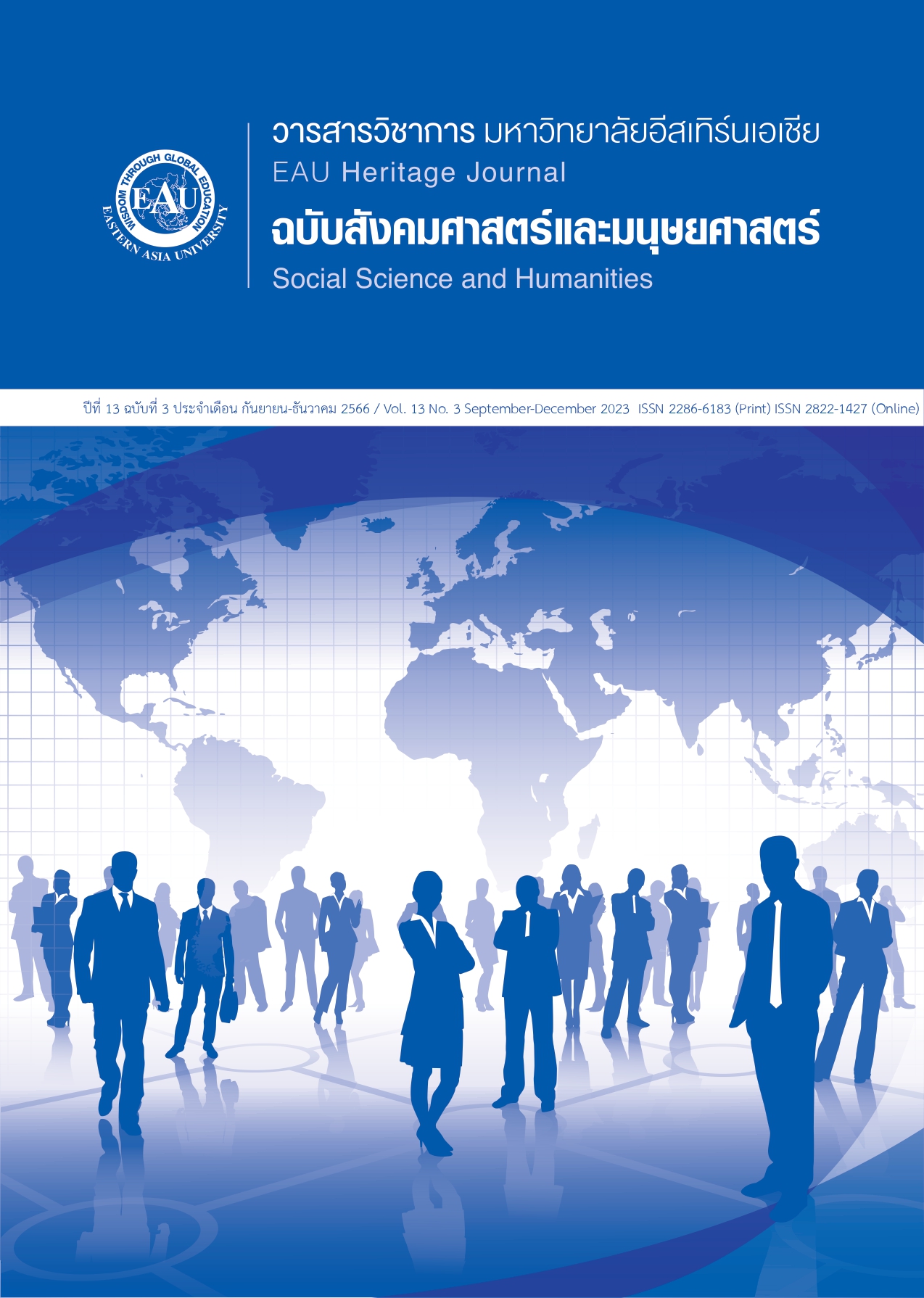Thai Massage: National Health Cultural Heritage
Keywords:
Culture, Health, Thai massageAbstract
The purpose of this Mixed Methods research were as following: (1) To study Thai massage curriculum national health cultural heritage (2) To study the model of Thai massage teachers national health cultural heritage (3) to study the invention of Thai massage postures national health cultural heritage Collecting data in 4 steps as follows: (1) study research collect theoretical information and related research (2) analyze the situation and create interview forms and questionnaires (3) collect data and experimental model to study the problematic condition of the Thai massage curriculum Thai massage teachers and develop a draft model Thai massage postures (4) data analysis summary discussion and suggestions. The results of the research revealed that (1) Thai massage curriculum teaching at present has several levels of teaching all courses offered must be certified by (1.1) Department of Health Service Support there are 13 courses that were standardized (1.2) Thai Traditional Medicine Council there were the course in applied Thai traditional medicine Thai traditional medicine Thai traditional medicine certificate and a Thai traditional medicine assistant (2) From answering the questionnaire of 30 most of them were female (67.00%) they were satisfied with massage with an average ( x̅ ) = 3.46 which was in the moderate level (3) Developing personnel to become role model teachers in Thai massage to raise the standards of Thai massage to international standards development of existing teacher personnel and the new generation of personnel to have desirable characteristics to be the identity of model teachers teacher personnel must adjust in teaching to be in line with the current situation and up-to-date all the time.
References
กองการประกอบโรคศิลปะ กรมสนับสนุนบริการสุขภาพ. (2543). ตำราแพทย์แผนโบราณทั่วไป สาขาเวชกรรมไทย. กรุงเทพฯ: กองประกอบโรคศิลปะ.
Division of the Art of Healing Department of Health Service Support. (2000). Textbook of
general traditional medicine. Branch of Thai Medicine. Bangkok: Medical Practitioner
Division. (in Thai).
กองคุ้มครองและส่งเสริมภูมิปัญญาการแพทย์แผนไทยและแพทย์พื้นบ้านไทย กรมการแพทย์แผนไทย. (2563). แผนยุทธศาสตร์การส่งเสริมและพัฒนานวดไทย (ฉบับที่ 1) นวดไทยมรดกไทยมรดกโลก พุทธศักราช 2563-2565. นนทบุรี
Protection and Promotion of Thai Traditional Medicine Wisdom and Thai Indigenous Medicine
Department of Thai Traditional Medicine. (2020). Strategic Plan for Promotion and
Development of Thai Massage (Version 1) Thai Heritage Thai Massage World Heritage
-2022. Nonthaburi. (in Thai).
ชูชาติ เชิงฉลาด. (2527). กระบวนการเตรียมการสอน. กรุงเทพมหานคร : ม.ป.ท
Choengchalad, C. (1984). Instructional preparation process. Bangkok: M.P.T. (in Thai).
ดาวรุ่ง ชะระอ่ำ. (2547). การพัฒนารูปแบบการผลิตวิชาชีพของไทย. วิทยานิพนธ์ปริญญาดุษฎีบัณฑิต สาขาวิชา
อุดมศึกษา, จุฬาลงกรณ์มหาวิทยาลัย.
Charaam, D. (2004). The Development of Professional Production Models in Thailand. Doctor
of Philosophy Thesis Higher Education, Chulalongkorn University. (in Thai).
ธีระศักดิ์ อัครบวร. (2542). ความเป็นครู. (พิมพ์ครั้งที่ 3). กรุงเทพฯ: โรงพิมพ์ ก.พลพิมพ์จำกัด.
Akkaraworn,T. (1999). Being a teacher (3nd ed). Bangkok: Kopol Phim Printing House. Co., Ltd. (in Thai).
บุญส่ง หาญพานิช. (2546). การพัฒนารูปแบบการบริหารจัดการความรู้ในสถาบันอุดมศึกษาไทย. วิทยานิพนธ์
ปริญญาครุศาสตรดุษฎีบัณฑิต สาขาวิชาอุดมศึกษา, จุฬาลงกรณ์มหาวิทยาลัย.
Hanpanich, B. (2003). The Development of a Knowledge Management Model in Thai Higher
Education Institutions. Doctor of Education degree Thesis, Chulalongkorn University. (in Thai).
พันธ์เพ็ญ หีบเพ็ชร. (2540). คุณลักษณะที่พึงประสงค์ของครูสอนวิชาชีพระยะสั้นตามทัศนะของนักศึกษาผู้ใหญ่
วิทยาลัยสารพัดช่างเขตภาคใต้. ปริญญานิพนธ์การศึกษามหาบัณฑิต สาขาวิชาการศึกษาผู้ใหญ่,
มหาวิทยาลัยศรีนครินทรวิโรต
Heeppetch, P. (1997). Desirable characteristics of short-term vocational teachers according
to the perspective of adult students. Master of Education Thesis, Srinakharinwirot
University. (in Thai).
มหาวิทยาลัยพายัพ. (2556). คุณลักษณะบัณฑิตของมหาวิทยาลัยพายัพตามกรอบมาตรฐานคุณวุฒิ
ระดับอุดมศึกษาแห่งชาติ. รายงานวิจัยมหาวิทยาลัยพายัพ, จังหวัดเชียงใหม่.
University, P. (2013). Characteristics of graduates of Payap University according to the Higher
Education Qualifications Framework. Payap University Research Report, Chiang Mai
University. (in Thai).
ยงศักดิ์ ตันติปิฎก. (2559). ตำราการนวดไทย เล่ม 1 (พิมพ์ครั้งที่ 5). กรุงเทพฯ:มูลนิธิสาธารณสุขกับการพัฒนา
Tantipitok, Y. (2016). Textbook of Thai massage volume 1 (5th ed). Bangkok: Public Health and
Development Foundation. (in Thai).
ยนต์ ชุ่มจิต. (2550). ความเป็นครู (พิมพ์ครั้งที่ 4). กรุงเทพฯ : โอเดียนสสโตร์.
Chumchit, Y. (2007). Teachership (4th ed). Bangkok: Odeon Store. (in Thai).
ยงศักดิ์ ตันติปิฎก. (2561). นวดไทย มรดกภูมิปัญญาทางวัฒนธรรม. กรุงเทพฯ: กรมส่งเสริมวัฒธนธรรม
Tantipitok, Y. (2018). Thai Massage Intangible Cultural Heritage. Bangkok: Department of Cultural Promotion. (in Thai).
โรจน์รวี พจน์พัฒนพล. (2552). คุณลักษณะของบัณฑิตที่พึงประสงค์ในทรรศนะของนักศึกษามหาวิทยาลัย
เทคโนโลยีราชมงคลพระนคร. รายงานวิจัยคณะศิลปะศาสตร์, มหาวิทยาลัยเทคโนโลยีราชมงคลพระนคร.
Pojpattanapol, R. (2009). Characteristics of Desirable Graduates in the Views of University of
Technology Students Rajamangala Phra Nakhon. Faculty of Arts Research Report,
Rajamangala University of Technology Phra Nakhon. (in Thai).
วราศิริ วงศ์สุนทร. (2543). การเรียนรู้อย่างมีความสุข : การวิจัยรายกรณีครูต้นแบบด้านการสอนวิชาภาษาไทย
ระดับชั้นประถมศึกษา. วิทยานิพนธ์ ปริญญาคุรุศาสตร์มหาบัณฑิต ภาควิชาภาควิชาการศึกษา คณะคุรุศาสตร์จุฬาลงกรณ์มหาวิทยาลัย
มาลินี จุฑะรพ. (2539). จิตวิทยาการเรียนการสอน (พิมพ์ครั้งที่ 2). กรุงเทพฯ : ทิพยวสิุทธิ์.
Jutharop, M. (1996). Psychology of teaching and learning (2nd ed). Bangkok: Thiphayawasit. (in Thai).
มูลนิธิการแพทย์แผนไทยพัฒนา. (2550). คู่มือการนวดรักษาโรคแบบราชสำนัก. กรุงเทพฯ: ศูนย์พัฒนาตำรา
การแพทย์แผนไทย มูลนิธิการแพทย์แผนไทยพัฒนา.
Foundation of Thai Traditional Medicine Development. (2007). A manual for therapeutic
massage of the royal court. Bangkok: Textbook Development Center Thai traditional
medicine Foundation of Thai Traditional Medicine Development. (in Thai).
มูลนิธิเพื่อเด็กพิการ. (2555). ตำราการนวดไทยบำบัด (พิมพ์ครั้งที่ 4). กรุงเทพฯ : มูลนิธิเพื่อเด็กพิการ
Foundation for children with disabilities. (2012). Textbook of Thai massage therapy. (4th ed) .
Bangkok: Foundation for Children with Disabilities. (in Thai).
ภคมน นาถเสว. (2563). การขึ้นทะเบียน “นวดไทย” เป็นมรดกทางวัฒนธรรมที่จับต้องไม่ได้ของมนุษยชาติตาม
อนุสัญญาว่าด้วยการสงวนรักษามรดกทางวัฒนธรรมที่จับต้องไม่ได้. ค้นจาก
https://lawforasean.krisdika.go.th/Content/View?Id=749&Type=1
Natsavee, P. (2020). Registration of “Thai massage” as an intangible cultural heritage of
humanity according to Convention for the Safeguarding of the Intangible Cultural
Heritage. search from https://lawforasean.krisdika.go.th/Content/View?Id=749&Type=1. (in Thai).
อภิชาติ ลิมติยะโยธิน และคณะ. (2556). คู่มืออบรมการนวดไทยแบบราชสำนัก : ภาคเทคนิค การนวดรักษา
อาการโรคที่พบบ่อย (พิมพ์ครั้งที่ 2). นนทบุรี : มูลนิธิการแพทย์แผนไทยพัฒนา
Limtiyayothin, A. et al. (2013). Handbook of Royal Thai Massage Training: Techniques of
therapeutic massage. common disease symptoms (2nd edi). Nonthaburi: Thai
Traditional Medicine Foundation. (in Thai).





